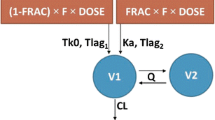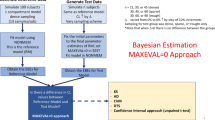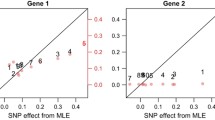Abstract
Pharmacogenetics is now widely investigated and health institutions acknowledge its place in clinical pharmacokinetics. Our objective is to assess through a simulation study, the impact of design on the statistical performances of three different tests used for analysis of pharmacogenetic information with nonlinear mixed effects models: (i) an ANOVA to test the relationship between the empirical Bayes estimates of the model parameter of interest and the genetic covariate, (ii) a global Wald test to assess whether estimates for the gene effect are significant, and (iii) a likelihood ratio test (LRT) between the model with and without the genetic covariate. We use the stochastic EM algorithm (SAEM) implemented in MONOLIX 2.1 software. The simulation setting is inspired from a real pharmacokinetic study. We investigate four designs with N the number of subjects and n the number of samples per subject: (i) N = 40/n = 4, similar to the original study, (ii) N = 80/n = 2 sorted in 4 groups, a design optimized using the PFIM software, (iii) a combined design, N = 20/n = 4 plus N = 80 with only a trough concentration and (iv) N = 200/n = 4, to approach asymptotic conditions. We find that the ANOVA has a correct type I error estimate regardless of design, however the sparser design was optimized. The type I error of the Wald test and LRT are moderatly inflated in the designs far from the asymptotic (<10%). For each design, the corrected power is analogous for the three tests. Among the three designs with a total of 160 observations, the design N = 80/n = 2 optimized with PFIM provides both the lowest standard error on the effect coefficients and the best power for the Wald test and the LRT while a high shrinkage decreases the power of the ANOVA. In conclusion, a correction method should be used for model-based tests in pharmacogenetic studies with reduced sample size and/or sparse sampling and, for the same amount of samples, some designs have better power than others.






Similar content being viewed by others
References
EMEA (2008) ICH topic E15 definitions for genomic biomarkers, pharmacogenomics, pharmacogenetics, genomic data and sample coding categories. Technical report, EMEA
FDA (2008) E15 definitions for genomic biomarkers, pharmacogenomics, pharmacogenetics, genomic data and sample coding categories. Technical report, FDA
EMEA (2007) Reflection paper on the use of pharmacogenetics in the pharmacokinetic evaluation of medicinal products. Technical report, EMEA
Hu XP, Xu JM, Hu YM, Mei Q, Xu XH (2007) Effects of CYP2C19 genetic polymorphism on the pharmacokinetics and pharmacodynamics of omeprazole in chinese people. J Clin Pharmacol Ther 32:517–524
Hirt D, Mentré F, Tran A, Rey E, Auleley S, Salmon D, Duval X, Tréluyer JM, COPHAR2-ANRS Study Group (2008) Effect of CYP2C19 polymorphism on nelfinavir to M8 biotransformation in HIV patients. Br J Clin Pharmacol 65:548–57
Yamasaki Y, Ieiri I, Kusuhara H, Sasaki T, Kimura M, Tabuchi H, Ando Y, Irie S, Ware JA, Nakai Y, Higuchi S, Sugiyama Y (2008) Pharmacogenetic characterization of sulfasalazine disposition based on NAT2 and ABCG2 (Bcrp) gene polymorphisms in humans. Clin Pharmacol Ther 84:95–103
Li D, Lu W, Zhu JY, Gao J, Lou YQ, Zhang GL (2007) Population pharmacokinetics of tacrolimus and CYP3A5, MDR1 and IL-10 polymorphisms in adult liver transplant patients. Clin Pharm Ther 32:505–515
Bertrand J, Comets E, Mentré F (2008) Comparison of model-based tests and selection strategies to detect genetic polymorphisms influencing pharmacokinetic parameters. J Biopharm Stat 18:1084–1102
Sheiner L, Beal S (1998) NONMEM Version 5.1. University of California, NONMEM Project Group, San Francisco
Lavielle M (2008) MONOLIX (MOdèles NOn LInéairesà effets miXtes). MONOLIX Group, Orsay, France, 2008. http://www.software.monolix.org/index.php
Duval X, Mentré F, Rey E, Auleley S, Peytavin G, Biour M, Métro A, Goujard C, Taburet AM, Lascoux C, Panhard X, Tréluyer JM, Salmon D (2009) Benefit of therapeutic drug monitoring of protease inhibitors in HIV-infected patients depends on PI used in HAART regimen—ANRS 111 trial. Fundam Clin Pharmacol. in press
Bertrand J, Treluyer JM, Panhard X, Tran A, Rey SE, Salmon-Céron D, Duval X, Mentré F, COPHAR2-ANRS 111 Study Group (2009) Influence of pharmacogenetics on indinavir disposition and short-term response in HIV patients initiating HAART. Eur J Clin Pharmacol 65:667–678
Retout S, Comets E, Le Nagard H, Bazzoli C, Mentré F (2007) PFIM Interface 2.1. UMR738, INSERM, Université Paris 7, Paris, France, http://www.pfim.biotstat.fr
Retout S, Comets E, Samson A, Mentré F (2007) Design in nonlinear mixed effects models: optimization using the Fedorov-Wynn algorithm and power of the Wald test for binary covariates. Stat Med 26:5162–5179
Pillai GC, Mentré F, Steimer JL (2005) Non-linear mixed effects modeling—from methodology and software development to driving implementation in drug development science. J Pharmacokinet Pharmacodyn 32:161–183
Deylon B, Lavielle M, Moulines E (1999) Convergence of a stochastic approximation version of EM algorithm. Ann Stat 27:94–128
Samson A, Lavielle M, Mentré F (2007) The SAEM algorithm for group comparison tests in longitudinal data analysis based on non-linear mixed-effects model. Stat Med 26:4860–4875
Box GEP, Andersen SL (1955) Permutation theory in the derivation of robust criteria and the study of departures from assumption. J R Stat Soc Ser B Meth 17:1–34
Beal SL (2001) Ways to fit a PK model with some data below the quantification limit. J Pharmacokinet Pharmacodyn 28:481–504
Fellay J, Marzolini C, Meaden E, Back D, Buclin T, Chave J (2002) Response to antiretroviral treatment in HIV-1-infected individuals with allelic variants of the multidrug resistance transporter gene MDR1: a pharmacogenetic study. Lancet 359:30–36
Solas C, Simon N, Drogoul NP, Quaranta S, Frixon-Marin V, Bourgarel-Rey V, Brunet C, Gastaut JA, Durand A, Lacarelle B, Poizot-Martin I (2007) Minimal effect of MDR1 and CYP3A5 genetic polymorphisms on the pharmacokinetics of indinavir in HIV-infected patients. Br J Clin Pharmacol 64:353–362
Sakaeda T, Nakamura T, Okumura K (2002) MDR1 genotype-related pharmacokinetics and pharmacodynamics. Biol Pharm Bull 25:1391–1400
Marzolini C, Paus E, Buclin T, Kim RB (2003) Polymorphisms in human MDR1 (p-glycoprotein): recent advances and clinical relevance. Clin Pharmacol Ther 75:13–33
Sackett DL, Haynes RB, Guyatt GH, Tugwellrada P (1991) Clinical epidemiology. A basic science for clinical medecine, 2nd edn. Little Brown, Boston.
Karlsson MO, Savic RM (2007) Diagnosing model diagnostics. Clin Pharm Ther 82:17–20
Robert CP (1994) The Bayesian Choice. A decision-theoretic motivation. Springer-Verlag, New York
Verbeke G, Molenberghs G (2000) Linear mixed models for longitudinal data. Springer-Verlag, New York
Panhard X, Samson A (2009) Extension of the SAEM algorithm for nonlinear mixed models with 2 levels of random effects. Biostatistics 10:121–135
Wählby U, Jonsson EN, Karlsson MO (2001) Assessment of actual significance levels for covariate effects in NONMEM. J Pharmacokinet Pharmacodyn 28:231–252
Gobburu JV, Lawrence J (2002) Application of resampling techniques to estimate exact significance levels for covariate selection during nonlinear mixed effects model building: some inferences. Pharm Res 19:92–98
Bonate PL (2005) Covariate detection in population pharmacokinetics using partially linear mixed effects models. Pharm Res 22:541–549
Comets E, Mentré F (2001) Evaluation of tests based on individual versus population modeling to compare dissolution curves. J Biopharm Stat 11:107–123
Panhard X, Mentré F (2005) Evaluation by simulation of tests based on non-linear mixed-effects models in pharmacokinetic interaction and bioequivalence cross-over trials. Stat Med 24:1509–1524
Box GEP (1954) Some theorems on quadratic forms applied in the study of analysis of variance problems, i. effect of inequality of variance in the one-way classification. Ann Math Stat 25:290–302
Crow JF (1999) Hardy, Weinberg and language impediments. Genetics 152:821–825
Panhard X, Taburet AM, Piketti C, Mentré F (2007) Impact of modelling intra-subject variability on tests based on non-linear mixed-effects models in cross-over pharmacokinetic trials with application to the interaction of tenofovir on atazanavir in HIV patients. Stat Med 26:1268–1284
Dartois C, Lemenuel-Diot A, Laveille C, Tranchand B, Tod M, Girard P (2007) Evaluation of uncertainty parameters estimated by different population pk software and methods. J Pharmacokinet Pharmacodyn 34:289–311
Kuhn E, Lavielle M (2005) Maximum likelihood estimation in nonlinear mixed effects models. Comput Stat Data Anal 49:1020–38
White DB, Walawander CA, Liu DY, Grasela TH (1992) Evaluation of hypothesis testing for comparing two populations using NONMEM analysis. J Pharmacokinet Biopharm 20:295–313
Lee PI (2001) Design and power of a population pharmacokinetic study. Pharm Res 18:75–82
Manly BFJ (1998) Randomization, bootstrap and Monte Carlo methods in biology, 2nd edn. Chapman & Hall, London
Elston DA (1998) Estimation of denominator degrees of freedom of F-distributions for assessing Wald statistics for fixed-effect factors in unbalanced mixed models. Biometrics 54:1085–1096
Chou M, Bertrand J, Segeral O, Verstuyft C, Borand L, Comets E, Becquemont L, Ouk V, Mentré F, Taburet AM (2009) Inter- and intra-patient variabilities in nevirapine plasma concentrations in HIV-infected cambodian patients and the effect of CYP2B6 genetic polymorphism: ANRS 12154 study. 16th conference on retroviruses and opportunistic infections, Montreal, Canada
Gabriel SB, Schaffner SF, Nguyen H, Moore JM, Roy J, Blumenstiel B, Higgins J, DeFelice M, Lochner A, Faggart M, Liu-Cordero SN, Rotimi C, Adeyemo A, Cooper R, Ward R, Lander ES, Daly MJ, Altshuler D (2002) The structure of haplotype blocks in the human genome. Science 296:2225–2229
Zhang L, Beal SL, Sheiner LB (2003) Simultaneous vs. sequential analysis for population PK/PD data I: best-case performance. J Pharmacokinet Pharmacodyn 30:387–404
Acknowledgments
We would like to thank the COPHAR 2-ANRS 111 scientific committee (investigators: Pr. D. Salmon and Dr. X. Duval, pharmacology: Pr. J. M. Tréluyer, methodology: Pr. F. Mentré) for giving us access to the pharmacogenetic data of the indinavir arm in order to build our simulations. We would also like to thank the IFR02 of INSERM and Hervé Le Nagard for the use of the “centre de biomodélisation” as well as the Pr. Marc lavielle for the precious help he provided in using MONOLIX. During this work, Céline M. Laffont was working at the Institut de Recherches Internationales Servier as pharmacometrician and Julie Bertrand was supported by a grant from the Institut de Recherches Internationales Servier.
Author information
Authors and Affiliations
Corresponding author
Rights and permissions
About this article
Cite this article
Bertrand, J., Comets, E., Laffont, C.M. et al. Pharmacogenetics and population pharmacokinetics: impact of the design on three tests using the SAEM algorithm. J Pharmacokinet Pharmacodyn 36, 317–339 (2009). https://doi.org/10.1007/s10928-009-9124-x
Received:
Accepted:
Published:
Issue Date:
DOI: https://doi.org/10.1007/s10928-009-9124-x




